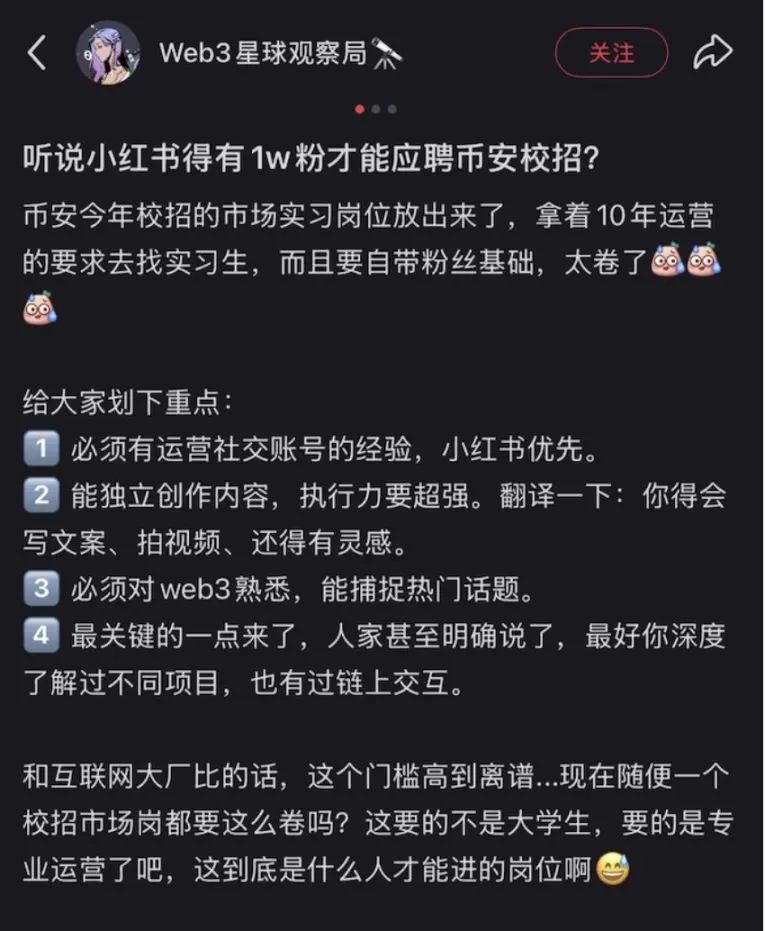Author: Ada, Deep Tide TechFlow
"I heard you need 10,000 followers on Xiaohongshu to apply for Binance's campus recruitment?"

A screenshot from Xiaohongshu exploded in the crypto job-seeking group.
"It's harder than having a 985 degree," someone joked in the comments.
In fact, there is no "hard follower threshold" in Binance's official job description, but it clearly states: "Experience in successfully managing social media accounts is preferred, especially in video, Xiaohongshu, and AI-related content."
This is not just a joke. Crypto KOL "AB Kuai.Dong" bluntly stated on X (Twitter):
"The attitude of major exchanges towards Xiaohongshu has shifted from 'should we do it' to 'can we do it big.' Now they are even specifically recruiting fresh graduates with experience in building accounts on Xiaohongshu."
From Weibo, Twitter, Douyin, to now Xiaohongshu, the marketing battlefield for exchanges is quietly shifting.
This shift is not a momentary impulse.
Between 2023 and 2024, the user profile of Xiaohongshu underwent a key change: content related to investment, overseas living, and remote work saw exponential growth; users aged 25-35, from first and second-tier cities, with a bachelor's degree or higher accounted for over 60%.
These individuals are precisely the core users that cryptocurrency exchanges are eager to compete for.
On this platform that started with beauty and fashion, exchanges are cautiously testing the boundaries, packaging their "ambitions" with street interviews, workplace stories, and wealth notes.
Is Xiaohongshu really the new growth paradise for the crypto industry?
The Migration History of Crypto Traffic
To understand why exchanges are betting on Xiaohongshu, one must first grasp a "history of crypto traffic migration."
In the memories of many old crypto enthusiasts, Weibo has long been the center of public opinion in the Chinese crypto world.
Between 2017 and 2022, executives from major exchanges would publicly tear each other apart on Weibo, competing for personas and making bold statements, resembling an "open arena" for the industry. Many newcomers completed their first trades through the popular science and calls to action from crypto bloggers on Weibo.
At that time, whenever Bitcoin surged, a certain exchange would spend money to buy trending topics on Weibo, allowing terms like "Bitcoin skyrockets" to climb the charts, attracting countless retail investors to watch.
However, everything came to a halt after regulations were implemented. With tightening policies, industry OG accounts like Sun Yuchen and He Yi were shut down, and many KOLs were completely cleared out. Various groups were forced to migrate, ultimately converging on today's X (Twitter), forming a new Chinese crypto social circle.
Today, X (Twitter) is undoubtedly the largest "square" in the crypto world—Vitalik publishes Ethereum upgrade progress here, CZ responds to doubts here, and various KOLs engage in verbal battles here. But the problem lies precisely here: it is too "insider."
After years of traffic competition, potential new crypto users have long been divided among KOLs with invitation links, and the current market resembles a tug-of-war among existing users.
For the vast number of Chinese-speaking users, Twitter has always been separated by a glass wall, unable to reach the sinking market or engage a broader audience.
Douyin was once seen as a potential "crypto traffic gold mine." It has unparalleled content explosiveness, but the problem is: this explosiveness is hard to solidify.
Fast-food content consumption makes it difficult to establish the trust needed for financial products.
"The lifecycle of Douyin content is too short," commented new media analyst You Mu Zhi, "its original design is for exposure and traffic, not trust. Once it leaves Douyin, its vitality quickly diminishes, and its influence is hard to settle into users' daily lives."
Bilibili once carried the educational content of exchanges, from "cryptocurrency popular science" to "strategy teaching," serving as a window to attract new users.
Like Weibo's predicament, as regulations tightened, terms like "Bitcoin" and "exchange" faced systematic traffic restrictions, leaving creators exhausted, and the stability of exchanges' advertising gradually diminished.
Unlike these old battlefields, Xiaohongshu has quietly but thoroughly evolved over the past two years.
It is no longer just a community for sharing beauty and fashion. Content related to investment, technology exploration, and overseas living has seen exponential growth, with users aged 25-35, holding a bachelor's degree or higher, from first and second-tier cities, accounting for over 60%.
This group of people is precisely the core clientele that crypto exchanges dream of capturing.
More importantly, Xiaohongshu's traffic distribution method is completely different from Douyin.
It does not rely on the monopoly of top influencers but allows KOCs with only 1,000 followers to gain significant exposure. For example, a post by an ordinary user on Xiaohongshu saying "Bybit can still open cards, hurry up" can receive thousands of likes and interactions.
Another secret weapon of Xiaohongshu is its natural "trust chain."
Unlike public domain traffic platforms, Xiaohongshu's community is centered around human connection. Users interact with bloggers in the comments, consult via private messages, and even pull each other into group chats, making the entire process feel like word-of-mouth recommendations among friends rather than cold advertisements.
For high-threshold, high-learning-cost crypto products, this chain means a shorter conversion distance.
A research report from Newrank even referred to Xiaohongshu as the "trust engine of social e-commerce":
It combines the traffic of influencers, the information flow of sales, and the attributes of consumer opinion leaders, with traffic relying more on users actively searching rather than platform recommendations, making sales conversions more precise and less likely to provoke aversion.
Therefore, when we see Binance, OKX, and Bitget starting to allocate resources to Xiaohongshu, it is not a momentary "trick," but a strategic bet that aligns with the new traffic logic.
The Secret Growth Techniques of Exchanges
"OKX has cut more than half of its KOL advertising budget on Twitter and is now focusing heavily on Xiaohongshu. Multiple departments internally are working on Xiaohongshu, and almost all members of the Chinese department are involved."
Crypto bloggers fearlessly expose on X.
On Xiaohongshu, an OKX street interview video themed "Beijing Film Academy Beauty" has garnered over 87,000 likes. Similar street interview themes can easily break 10,000 likes each time, and the Nezha series of AI short films can also receive thousands of saves.
OKX clearly does more than just shoot videos. Its approach on Xiaohongshu resembles a meticulously planned marketing layout: the official account creates topics, while employee accounts infiltrate various content circles, creating a matrix-like penetration.
In addition to the official account, employees like Jiu Mei, Mercy, and Mia have accumulated a large following with workplace narratives such as "Experience Switching to Web3" and "Daily Life at an Exchange." They appear independent but frequently interact with the official account in the comments, generating secondary exposure for the brand and creating a sense of closeness.

This matrix approach can hedge against account bans while allowing the brand to penetrate more segmented audience pools, such as young professionals wanting to enter Web3 or freelancers pursuing a "digital nomad" lifestyle.
However, for exchanges, Xiaohongshu's role may not only be to acquire direct registered users. More often, it serves as a "brand showcase"—through content penetration, familiarizing and recognizing potential users with the exchange's brand, so that when users have actual trading needs, they can think of it first.
Efficient conversion often occurs in the "underground world."
Several grassroots studios are long active on Xiaohongshu, tirelessly posting traffic-generating notes.
These notes often disguise themselves as "pitfall avoidance guides," "financial diaries," or "beginner tutorials," attracting users to join groups or private chats, and then throwing out registration links. Once users deposit funds and start trading, these promoters can earn long-term commission income, and some studios even directly post registration ads on Xiaohongshu—this is also one of the most stable gray businesses in the crypto circle.

On Xiaohongshu, cryptocurrencies are often not cold financial tools but are packaged as a lifestyle choice.
Instead of saying "invest in cryptocurrencies," they say "how I achieve a monthly passive income of over 10,000"; instead of discussing candlestick charts, they share financial insights from digital nomads; instead of talking about technical analysis, they discuss the path to wealth freedom for the post-00s…
This "lifestyle" packaging perfectly fits Xiaohongshu's content ecosystem and lowers the psychological threshold for users.
Crypto blogger Viki summarized the types of Web3 accounts with commercial value currently on Xiaohongshu:
- Career consulting: sharing career transition experiences to attract job seekers;
- Investment insights: seemingly lifestyle records, but actually investment tutorials;
- Lifestyle: stories of digital nomads, remote work, and overseas living;
- Personal IP: establishing trust through strong identity labels.
"Exchanges collaborate with KOLs or KOCs who have these four types of accounts, ultimately guiding users into communities and completing conversions through registered commission links," Viki explained.
Behind this, exchanges are attempting a long-term brand reshaping: transforming from cold trading tools into communities, companions, and even "narrative leaders."
Dancing on Thin Ice
The influx of crypto exchanges into Xiaohongshu seems to be the first step out of "crypto jargon" and into the mainstream social context, but this path is not smooth.
Trader "Coin Poison," who has 50,000 followers on Twitter, bluntly stated that doing Xiaohongshu is "extremely low cost-effective." He once paid the price of over 20 accounts due to constant account creation and repeated bans to figure out the rules.
"Back then, the industry hadn't rolled over; now every exchange is crazily entering, and the traffic is no longer a blue ocean." Another KOL, "Digital Wave," said that doing Xiaohongshu now feels like "inward competition within a besieged city," and the golden period has disappeared.
In addition to fierce competition, the platform's review mechanism is also a high wall.
"When traffic is low, it has no effect; when traffic is high, it triggers manual review," Viki summarized, "Once there are multiple violations, the consequences can range from limited traffic to account bans, making content creation feel like dancing with shackles."
To avoid pitfalls, many creators have to tailor unique strategies for different stages, from copywriting and layout to traffic design, further lowering the input-output ratio.
More troublesome are compliance and user cognition risks. The mainstream user group of Xiaohongshu is mostly young people who lack understanding of contracts, leverage, and on-chain assets. A slight misstep could lead to misleading information causing financial losses, triggering tighter regulations. Even though the platform currently maintains a certain degree of ambiguity regarding crypto content, as financial content management becomes standardized, any public relations disaster could lead to a complete ban.
The risks are evident, yet exchanges still invest heavily.
"If you don't push, your competitors will get ahead," said a marketing manager from an exchange.
This resembles a classic "prisoner's dilemma":
- If only you do it, you can indeed seize the benefits.
- If everyone does it, the benefits are diluted, and risks are amplified.
- If you don't do it, you watch your competitors harvest users.
So even knowing there are traffic traps and potential risks, one must jump in.
Breaking the circle has always come at a cost; the question is whether that cost is worth it.
The exchanges' adventures on Xiaohongshu feel like dancing on thin ice—every step could be the last, but when the music plays, no one wants to stop.
How long will this traffic carnival last? No one knows the answer.
The only certainty is that in an era where traffic is becoming increasingly expensive and regulations are tightening, the age of "easy money" is long gone. Exchanges need to think not only about how to acquire users but also about how to truly create value under the premise of compliance and sustainability.
Otherwise, today's Xiaohongshu could very well become tomorrow's Weibo.
History does not repeat itself, but it always rhymes.
免责声明:本文章仅代表作者个人观点,不代表本平台的立场和观点。本文章仅供信息分享,不构成对任何人的任何投资建议。用户与作者之间的任何争议,与本平台无关。如网页中刊载的文章或图片涉及侵权,请提供相关的权利证明和身份证明发送邮件到support@aicoin.com,本平台相关工作人员将会进行核查。




